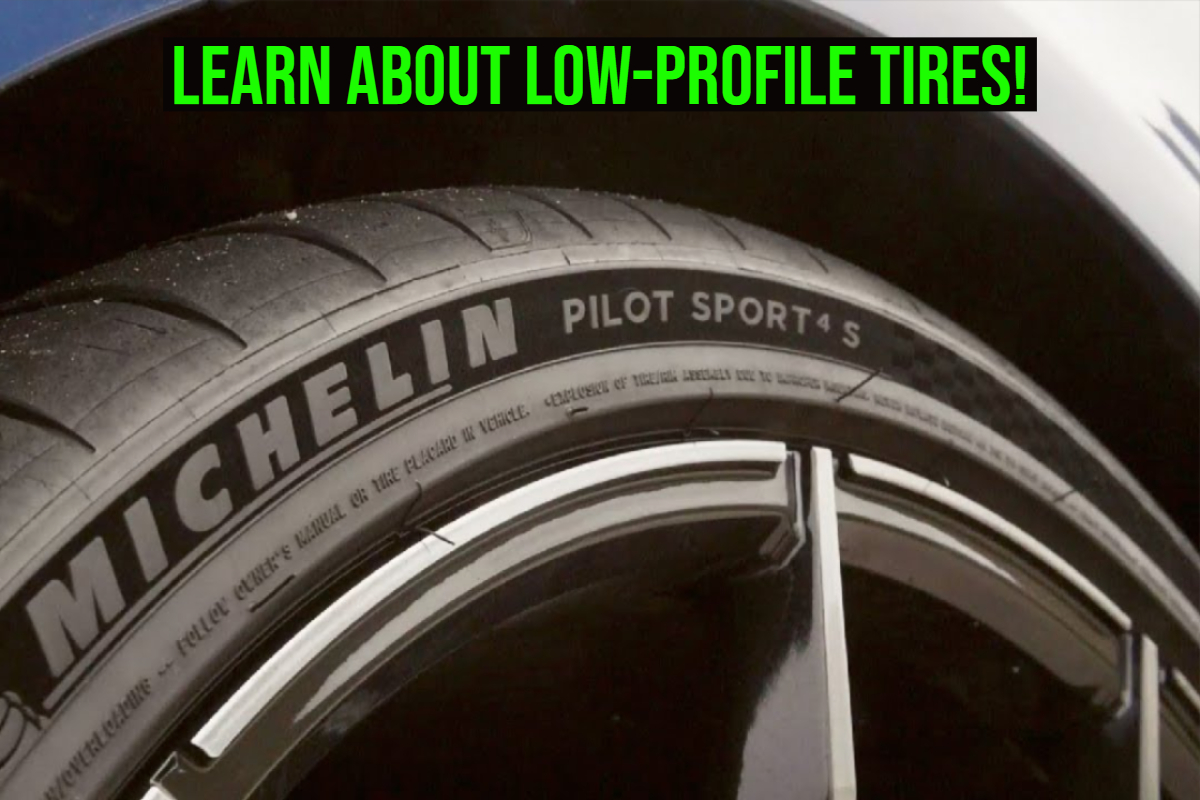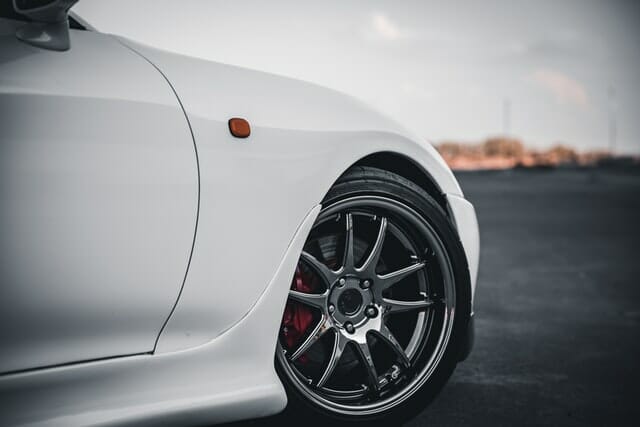How to Drive With Low Profile Tires
If you’re driving a performance car, chances are it’s equipped with low profile tires. These tires offer many benefits, but they can also be more difficult to drive on. Here are some tips for driving with low profile tires:
1. Be careful when going over bumps. Low profile tires don’t have as much cushioning as regular tires, so they can be more prone to damage from hitting curbs or potholes.2. Avoid sharp turns at high speeds.
Again, because of the lack of cushioning, low profile tires can lose grip more easily than regular tires. This is especially true if the road surface is wet or icy.3. Don’t overload your vehicle.
Low profile tires can be less resistant to heat build-up, so it’s important not to overload your vehicle or put too much stress on the tires by accelerating too quickly or braking too hard.
- Check your vehicle’s owner’s manual to see if low profile tires are recommended or allowed
- Purchase low profile tires that are the correct size and load rating for your vehicle
- Have the new tires installed by a qualified tire technician
- Follow the break-in procedures recommended by the tire manufacturer
- Drive slowly and carefully until you get used to the feel of the new tires
Why Not to Buy Low Profile Tires for Your Car
What are Low Profile Tires Good For?
When it comes to tires, there are a variety of different types that are designed for specific purposes. Low profile tires are one type that is growing in popularity, especially among sports car enthusiasts. But what exactly are low profile tires and what are they good for?
In general, low profile tires are those that have a shorter sidewall height in relation to the tire’s width. This gives the tire a lower overall profile, hence the name. Low profile tires can be used on a variety of different vehicles, but they’re most commonly seen on sports cars or luxury vehicles.
One of the biggest benefits of low profile tires is improved handling. With a shorter sidewall height, there’s less flex in the tire which means it can provide better grip and handling when cornering at high speeds. Additionally, low profile tires often offer better steering response due to their stiffer construction.
Another benefit of low profile tires is enhanced aesthetics. Many people simply prefer the way these tires look on their vehicle. They tend to give the car a more aggressive and sporty appearance.
Of course, there are some downsides to low profile tires as well. One is that they’re generally more expensive than other types of tires due to their specialized construction.
Do You Feel the Road More With Low Profile Tires?
As a driver, you may feel the road more with low profile tires. Low profile tires have a smaller sidewall and are designed for high-performance vehicles. They offer better handling and traction than regular tires, but they can also be more expensive.
If you’re driving on rough roads or in bad weather, you may want to consider using low profile tires.
How Long Can You Drive on Low Profile Tires?
Low profile tires are designed for high-performance vehicles and provide better handling and stability at high speeds. They also have a lower rolling resistance, which improves fuel economy. However, low profile tires wear out faster than regular tires and are more susceptible to punctures and damage from potholes.
For these reasons, it is important to know how long you can drive on low profile tires before they need to be replaced.Most tire manufacturers recommend replacing low profile tires after 40000-50000 miles of use. However, this varies depending on the brand and model of tire, as well as the type of vehicle you drive.
If you frequently drive in rough conditions or on unpaved roads, your tires may need to be replaced sooner. It’s always a good idea to check with your tire manufacturer or dealer for specific recommendations.
Are Low Profile Tires Better for Handling?
Most drivers believe that low profile tires offer better handling than regular tires. Low profile tires have a shorter sidewall and a wider tread, which gives them more contact with the road and makes them more responsive to steering input. They also provide better grip in corners and are less likely to hydroplane on wet roads.
However, low profile tires wear out faster than regular tires and are more susceptible to damage from potholes and curbs.

Credit: www.wheelhero.com
Low Pro Tires for 20 Inch Rims
When it comes to low pro tires, there are a few things that you need to know. First of all, what is a low profile tire? A low profile tire is simply a tire with a smaller sidewall.
The sidewall is the part of the tire that sits between the tread and the bead. A smaller sidewall means that there is less material between the tread and the bead, which results in a lower profile.One reason why you might want to consider low pro tires for your 20 inch rims is because they can help improve your fuel economy.
Low pro tires have less rolling resistance than regular tires, which means that they require less energy to move forward. This translates into better fuel economy because your engine doesn’t have to work as hard to move the wheels forward. In addition, low pro tires typically weigh less than regular tires, which also helps improve fuel economy.
Another reason to consider low pro tires for your 20 inch rims is because they can provide better handling characteristics. With less material between the tread and the bead, there is less flex in the sidewall of the tire. This means that the contact patch (the area of the tire that actually touches the ground) stays more consistent with each revolution, resulting in better grip and handling.
If you’re considering switching to low pro tires for your 20 inch rims, there are a few things you need to keep in mind. First of all, these tires typically cost more than regular tires. In addition, they may not be available in all size options for 20 inch rims.
Finally, if you live in an area with lots of snow and ice during wintertime, you’ll want to make sure that you choose a tire with good traction capabilities (such as studded snow tires).
Low Profile Tires for 18 Inch Rims
If you’re looking for a low profile tire for your 18 inch rims, there are a few things you need to know. First, what is a low profile tire? A low profile tire has a smaller sidewall height than a standard tire.
This gives the tire a lower “profile,” which makes it look bigger and wider. Low profile tires also tend to have better handling characteristics since they have less flex in the sidewall.There are tradeoffs to using low profile tires, though.
They don’t handle as well in rough terrain and can be more susceptible to punctures and other damage. They also tend to be more expensive than standard tires. But if you’re looking for better performance on the street or track, low profile tires are definitely the way to go.
When shopping for low profile tires, keep in mind that not all 18 inch rims will work with them. Some rims have too much offset or backspacing, which can cause clearance issues with the tires. It’s always best to consult with a Tire Rack expert before making your purchase to make sure everything will fit properly.
Low Profile Tires for 17 Inch Rims
If you’re in the market for new tires, you may be wondering if low profile tires are a good option for your car. Low profile tires can provide a number of benefits, but they also have some drawbacks that you need to be aware of before making your purchase.One of the biggest advantages of low profile tires is that they offer improved handling.
Low profile tires have a shorter sidewall, which means they’re stiffer than traditional tires. This provides better cornering grip and improves overall handling performance.Another benefit of low profile tires is that they improve braking performance.
Since there’s less tire wall to flex when braking, low profile tires provide shorter stopping distances and better brake feel.However, there are some trade-offs that come with low profile tires. One is that they tend to ride harsher than traditional tires due to their stiffer construction.
This can make for a less comfortable ride, especially on rough roads. Additionally, low profile tires are more susceptible to damage from potholes and curbs since there’s less sidewall to absorb the impact.So, should you go with low profile tires?
It really depends on your driving needs and preferences. If you prioritize handling and braking performance over comfort, then low profile tires may be the right choice for you.
Conclusion
If you’re looking to upgrade your car’s performance, one of the best ways to do it is by switching to low profile tires. Low profile tires provide better grip and handling, and can help you corner better at high speeds. However, there are a few things you need to keep in mind when driving with low profile tires.
For one, always remember to check your tire pressure before hitting the road. Low profile tires tend to run a bit hotter than regular tires, so they require higher air pressure. Secondly, be mindful of speed bumps and potholes.
Because they have less cushioning, low profile tires are more susceptible to damage from impact. Lastly, take it easy when accelerating and braking. Sudden movements can cause the tire treads to lose contact with the road surface, leading to loss of control.
By following these tips, you’ll be able to get the most out of your low profile tires and enjoy improved performance on the road.


